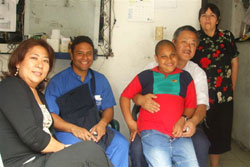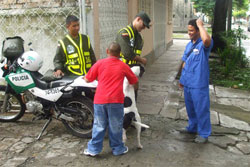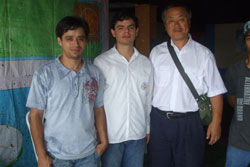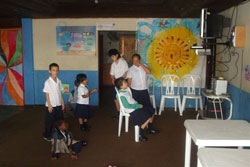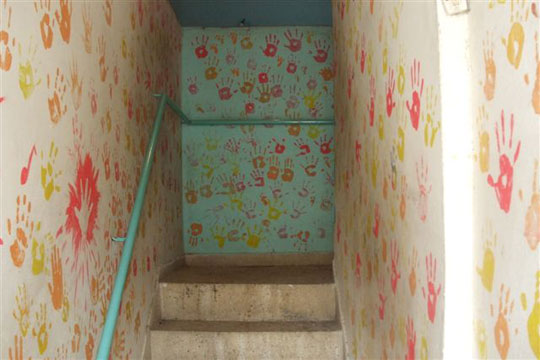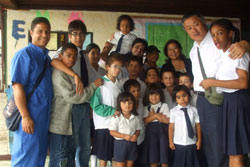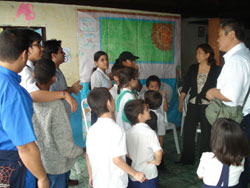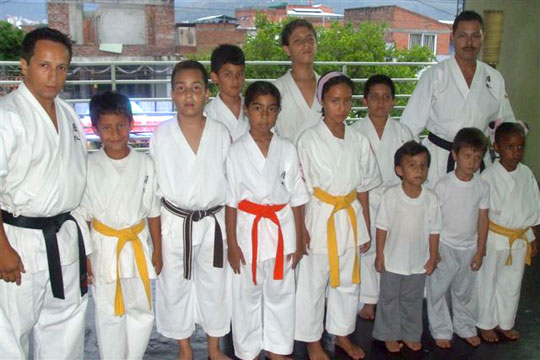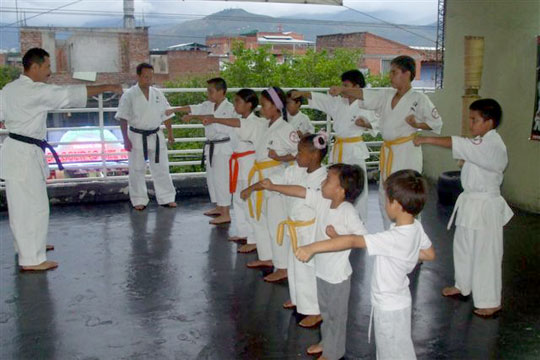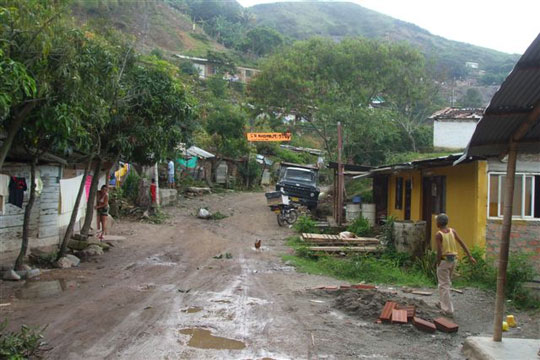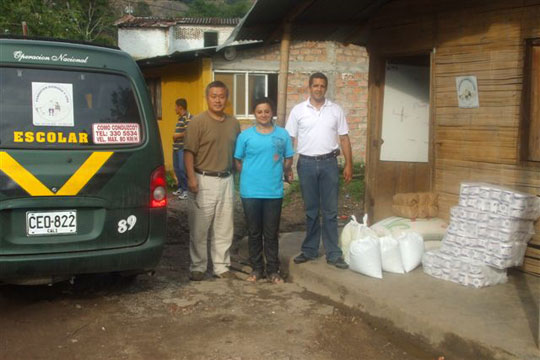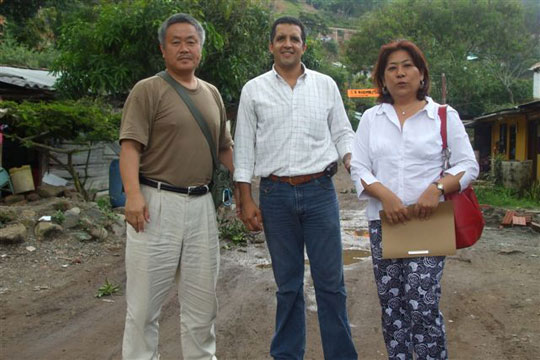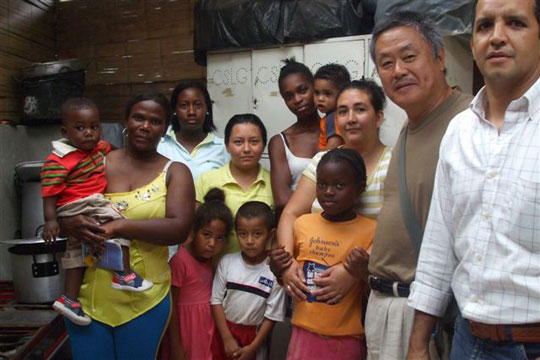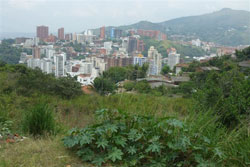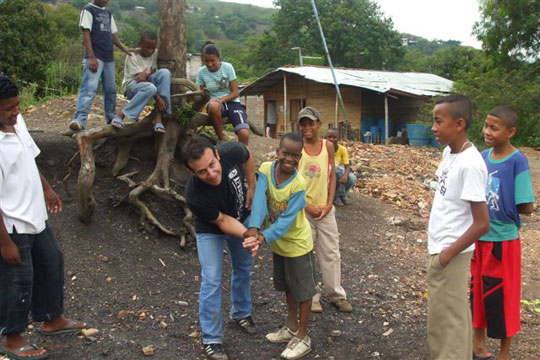Written by
Gaku Homma
Nippon Kan Kancho
May 5, 2008
Immigration was so crowded and the lines so long in Bogota that I missed my connection to Cali. This unfortunately was the last flight for the evening, which meant I would be spending the night in the airport. Colombia is a warm-weather country, but inside the airport was downright cold. The airport staff was very kind however and brought out a blanket for me on the bench I had settled on for the night. There was a woman I assumed was homeless who had taken up residence on the bench across from me, who was eyeing me somewhat suspiciously with half closed eyes. I was a little worried about what she was thinking about me. When I travel, I always wear clothes designed more for comfort and durability than fashion, and she was probably drawing the same conclusions about me that I had about her! “Maybe she can’t sleep either,” I thought as I settled in for the long night ahead.
Early the next morning I caught the first flight to Cali where the Nikeijin Kaikan (Japan Colombia Association) Director, Ayako Nakata and Cali Nippon Budokan’s Jorge Silva Sensei met me at the airport. They brought with them a large, beautiful arrangement of tropical flowers.
The hotel was 140 years old, very quaint and charming. The building also housed the Swiss Embassy which I thought was a unique combination. There were many families as guests at the hotel, but there was something out of place in their appearances that took me a little while to figure out. At breakfast one morning at the hotel, I overheard a couple’s conversation at the table next to me that helped me put the pieces together. “I liked this child” the woman said to her husband, “better than the others”.
I finally understood. This hotel that housed the Swiss Embassy was also a place for prospective parents to spend a little time with different children to choose a Colombian child for adoption. This seemed a little unreal to me. It reminded me of people at a pet store choosing a puppy to take home. I just hope that the children that were being chosen for adoption would be headed for a new and happy life.
***
When I wasn’t teaching Aikido at the Nippon Budokan, I spent my time researching different community service organizations and facilities in and around Cali. I was interested in what kinds of programs were facilitated there, and if any of them would be good candidates for future AHAN support.
The first organization I visited was the CADEYAR Foundation. This foundation was run by Andres Rodriguez Mera, an Aikido student of Jorge Silva Sensei. The CADEYAR facility provided physical therapy for children from low income families either free or administered for a nominal fee. Besides offering physical therapy for children with serious medical issues, they also arranged events and activities for these physically challenged children so they could interact together with healthy children for education, social development and a little fun! The CADEYAR Foundation receives no government support, and is funded entirely by private donations. As is usually the case, the CADEYAR Foundation struggled with a budget for its own survival. I asked Mr. Mera how much his salary was for working with the Foundation. He laughed at my question good naturedly and replied, “What salary”?
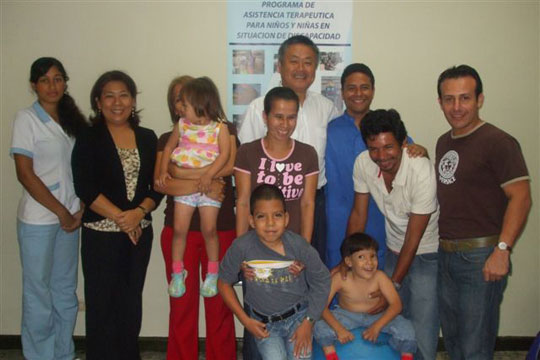
With patients, second from left; Ms. Nakata, far right; Jorge Silva Sensei, center: Homma Kancho, right of center; Mr. Mera.
We visited a boy named Luis who is a patient of Mr. Mera’s. Luis lives with his parents in a shack inside a private parking garage. The shack was about 50 square feet in size, and family members worked at parking lot attendants. Before Luis and his family moved to the parking garage they had lived in one of the very poor slum districts and Luis had been confined to a wheel chair. He received very little if any medical attention for his physical and mental handicaps. When his mother became seriously ill, the family moved into the city where she could be treated. The CEDEYAR Foundation found housing and employment for the family in the parking garage, medical attention for the mother and treatment and therapy for Luis. Since beginning therapy, Luis no longer needs a wheelchair. If fate had not allowed Luis to find assistance with the CEDEYAR Foundation he would have been confined to live in a wheelchair in the slums of outer Cali for the rest of his life.
I asked Luis which he liked better, living in the slums or living downtown. He said of course he liked living in the slum area better; all of his friends were there. He did appreciate however the treatment he and his family had received and a chance at a new life.
- Luis, (on Kancho’s knee) is doing much better now!
- Luis playing with policemen, to the right; Mr. Mera.
*****
Ten minutes by car northwest of Cali is an area called Terron, Colorado. Jorge Sensei and I had driven to Terron Colorado to visit a center that cares for some of the children in the area. As we approached the area, Jorge Sensei stopped his car and made a telephone call. Since drug dealing, crime and violence is prevalent in this area, Jorge Sensei was calling the police to give them his ID number, license plate number, and the reason for his visit to this area. Jorge Sensei’s car was equipped with a GPS tracking system that police could track if something were to happen to them. I suppose this was reassuring…
- Brothers, Luis and Dalio with Homma Kancho.
- Children in the main meeting hall.
Two brothers operate the Sole Luna Foundation (Sun and Moon Foundation) in a house they began renting in Terron Colorado five years ago. The house had very narrow steps that led up to the 10×10 square foot room that served as the central meeting area, and five small adjoining rooms. Mr. Dalio is the oldest of the two brothers at 34, with the younger brother Luis, 31. At any one time, there usually are about 30 children that frequented the facility. These children do not go to school and many of them are victims of abuse or neglect. This facility served as a day care shelter for many of the children including children with mental or physical difficulties. There is no where else in this area for these children to go, and there is no government funding for this foundation either. The City of Cali contributes a small amount of funds at times, but has provided no support since December. The $150.00 needed for rent every month has been difficult to raise, and the landlord as of late, has been asking them to leave if they could not pay. Food for the children costs about $2 per day per child, and the Foundation relies heavily on donations from supermarkets in the area to feed the children. Besides the 30 children that spend most of their days at the facility, many more kids come from the neighborhood for lunch.
As difficult as this situation is for both the young leaders of this foundation and the children that gather under their care, the goodness of their hearts shone through in the brightness of their smiles.
- With the children.
- Homma Kancho talking with the children.
*****
After bidding our farewells and returning to Cali, we left the Nikeijin Kaikan again at 5 pm to visit another slum area and a Karate dojo named Kyomizu Dojo. Here Lincoln Sensei, who also practices Aikido with Jorge Sensei in Cali taught Gojuryu Karate Do to about 10 children from this very low income neighborhood. Lincoln Sensei made his living as a trainer in a gym that occupied the same building as the Karate dojo. All of the children performed a demonstration for me that was quite good. This dojo was small, but this young, energetic instructor filled this space with a powerful and healthy practice.
- Lincoln Sensei (far left) with his enthusiastic students.
- Children’s practice.
*****
The following morning at 10 am, I went to the village of Santa Elena to visit the Dignity and Life Foundation. This foundation is run by Mr Mario Palomino who is also a student at the Nippon Budokan dojo. The Dignity and Life Foundation was founded by Mario’s wife, Juliette who is a well known radio host in Cali. Mario became more involved with running the foundation after a severe motorcycle accident. The accident almost killed him, and taught him about the preciousness of life. Mario also owns a computer business, but since the accident spends all of his free time as director of the center.
- Gate to Santa Elena.
- Food and daily product delivery, center; founder Juliette, right Mr. Mario, left; Homma Kancho.
Mr. Mario came to pick me up at the hotel and the trip to Santa Elena was an adventure in itself. The road to Santa Elena runs through the outskirts of a very affluent area of Cali. Once through this well-groomed area, the pavement came to an abrupt end, replaced suddenly by a rutted road in horrible disrepair. Afive-minute drive into the surrounding hills brought us to the shanty town of Santa Elena, a village of sorts which had sprouted up haphazardly around a rock quarry. I learned the quarry was owned by the city of Cali and that anyone who went through the trouble could mine the rock for free. The villagers of Santa Elena made their living with this grueling task of mining the rock and selling it to the more affluent people of Cali. In teams of four, the villagers cut and brought down slabs of rock used to tile the more rich homes and businesses in Cali. One day of back-breaking work would bring the team of four about $25, meaning that each person took home less than $10 for an eight-hour day of work. There were about 240 families that lived around the quarry in Santa Elena, and each family averaged from 7 to 8 children each.
At the entrance to the village, Mr. Mario built a bamboo hut where about 150 children have come for lunch every day for the last five years. On Saturdays and Sundays, the children receive two meals a day. Most of these children cannot go to school, so many of them stay at the hut after lunch to be tutored in basic studies, or just spend a little time talking and listening to the advice and guidance offered by Mr. Mario and his wife.
- Homma Kancho, Mr. Mario and Ms Nakata in Santa Elena
- Meeting hall.
Lunch consisted of rice, a thin bean soup and water sweetened with brown sugar. Once in a great while, a bite or two of chicken is included which was always a treat. Each month, the program consumes 150 kilos of beans, 300 kilos of rice and LOTS of brown sugar. The families of Santa Elena rotate the duty of cooking the children’s daily meal in their sparse and meager homes. Fresh water only flows in Santa Elena one hour per week, when the water pipes that run to the village square are turned on. Rain water is a valuable commodity here and is collected in a number of inventive ways every time it rains.
- Kancho with volunteer mothers.
- The hanging bicycle.
The day I visited the Dignity and Life Foundation there was a brand new children’s mountain bike hanging from the ceiling of the facility. This bike I learned was supposed to be a Christmas present for one of the kids. This child however, had not kept up his grades at school, so Mr. Mario had tied the bike to the ceiling where it remained; in sight but out of reach. Mr. Mario said with a smile, “Until this promise has been honored and his grades improve, that bicycle will stay out of reach on the ceiling,” he said. Listening to him, I could see the insight that Mr. Mario had and the kind of positive effect that he will have on the future of these children’s lives.
We left Santa Elena and made our way down the mountain and through some other poorer neighborhoods as we drove back towards Cali. Mr. Mario stopped the car when we reached the outskirts of the affluent area we had passed on the way up. He explained to me that urban neighborhoods are categorized into six income levels: zero through six. The area of Cali we just passed through was rated zero. The area we were headed into is rated six. The quarry village of Santa Elena does not even have a rank as the people who live there are actually squatters. The area around the quarry is actually too dangerous to be legally recognized by the city. That is why there are no social programs, infrastructure or even running water.
- Down the hill from a slum area is a “level 6” neighborhood.
- Collecting precious rainwater
Mr. Mario developed a special program in Santa Elena for about 20 young people aged 12 to 16, chosen for their aptitude and attitudes. These young people pile into an old van once a week where they are driven through the affluent areas of Cali to attend Aikido classes at the Nippon Budokan. These children would not be allowed to walk through any of the “six-rated areas they pass through on the way to the dojo; they would be chased out by police. This is one of the reasons that the children of Santa Elena rarely venture down from the quarry mountain on their own.
This program is supported by the Colombian Japanese Society, Jorge Sensei and Nakata Kancho and the children are enthusiastic participants in Aikido class. For these children, the fact that the toilets flush at the Nikeijin Kaikan, and that there is cold water that springs from the walls that you can drink is the most amazing thing of all.
*****
All of the foundations I visited in Cali were doing wonderful work, and each found their way into my heart. This time however, we selected the Dignity and Life Foundation for AHAN support . While in Cali, Ipersonally and on behalf of AHAN donated a month’s supply of food and other daily necessities.. We also discussed plans to establish a fundraising project at Nippon Kan Headquarters to supply 40 uniforms for the children of Santa Elena to wear to Aikido practice at the Nippon Budokan. We also discussed the possibility of coordinating a Japanese taiko druming concert in Cali this coming fall to raise funds to further support the Foundation’s programs.
It was a very short visit, but I was able to meet so many people related by Aikido that were giving so generously of themselves to their communities, so many that were sacrificing their time and talents for the benefit of others.
Reading this article might give you the impression that Cali is mostly made up of distressed and impoverish areas. This is not true, and I do not want to leave you with that impression about Cali. It is also a beautiful, prosperous city with a rich history and people rich in heart who understand the need to provide support and help for others who are less fortunate in the area.
I have learned and felt many things from this visit to Cali which have been very valuable for me. This trip also made me aware of how much I do not know about the country of Colombia and that my preconceptions were not at all based in the rich reality of this country I was delighted to visit.
To all of those I met in Cali, thank you very much for your care and generosity. I sincerely appreciate it.
Gaku Homma
Nippon Kan Kancho
—
Editors note
IMPORTANT UPDATE
On June 18th, 2008 40 keiko gis were delivered to the children of Santa Elena’s Dignity and Life Foundation by AHAN from the members of Nippon Kan Headquarters.


